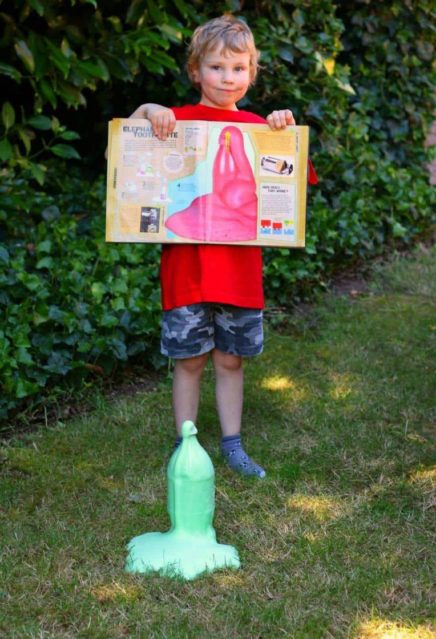
Being homeschoolers, we get to play at science fair all of the time, so a “Summer of STEM” is really just an excuse to make even more mess than usual, but with the bonus of it happening outside. This way there is less mess for me to clean up. Or, if we are honest here, less mess for me to look at and think “I really should clear that up.”
So what did we chose today?
There is, of course, the traditional Volcano experiment but we decided to try the slightly different ‘Elephant Toothpaste’ experiment found in the Dorling Kindersley book Science Rocks. I feel it is my duty, at this point, to give you fair warning, buying this book for your kids is a bit of a double-edged sword. It is packed full of unusual experiments and activities your kids will be desperate to try, along with plenty of easy to understand explanations about what is happening and why. They will have fun. They will learn. The bad thing about “Science Rocks” is that you will not be able to rest once the kiddos get their hands on it. Be prepared to have them constantly nag you to come and do “just one more thing.”
Don’t say I didn’t warn you.
Elephant Toothpaste

You will need:
- An empty plastic bottle
- 120 ml Hydrogen Peroxide (between 3 & 6 percent concentration – no more than that)
- Dishwashing Liquid
- Food Colouring
- Dry Yeast
- Hot Water
- Funnel
- Tray

Instructions
- Stand the bottle on a tray (or out on the grass in the garden).
- Using the funnel, pour the hydrogen peroxide into the bottle & add a few drops of food coloring & dishwashing liquid.
- Mix the yeast with hot (but not boiling) water in a bowl.
- Using the funnel pour the yeast mixture into the bottle & quickly stand back!
- The liquid will start bubbling before producing a foam that will spurt from the neck of the bottle.


The yeast in this experiment acts as a catalyst. It speeds up the chemical reaction, the breaking down of the hydrogen peroxide into water and oxygen. The hydrogen locks onto the yeast and the yeast split it into water and oxygen, without being chemically changed itself. The oxygen produced combines with the dishwashing liquid to create the foam. Because this is an exothermic reaction (heat producing), it turns some of the water into steam. When you run your hands through the foam, you can feel the heat produced.













